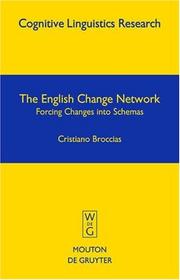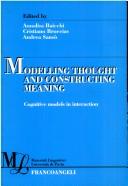| Listing 1 - 8 of 8 |
Sort by
|

ISBN: 311090120X 9783110901207 3110176467 9783110176469 Year: 2013 Volume: 22 Publisher: Berlin Boston
Abstract | Keywords | Export | Availability | Bookmark
 Loading...
Loading...Choose an application
- Reference Manager
- EndNote
- RefWorks (Direct export to RefWorks)
This book introduces the notion of change construction and systematically studies, within a Cognitive Grammar framework, the rich inventory of its instantiations in English, from well-known structures such as the so-called resultative construction to a variety of largely ignored types such as asymmetric resultatives, sublexical change constructions and mildly causal constructions.
English language --- Cognitive grammar. --- Cognitive linguistics --- Grammar, Comparative and general --- Psycholinguistics --- Syntax. --- 802.0-56 --- 802.0-56 Engels: syntaxis; semantiek --- Engels: syntaxis; semantiek --- Germanic languages
Book
ISBN: 9783031466021 Year: 2024 Publisher: Cham : Springer International Publishing : Imprint: Springer,
Abstract | Keywords | Export | Availability | Bookmark
 Loading...
Loading...Choose an application
- Reference Manager
- EndNote
- RefWorks (Direct export to RefWorks)
This book approaches the field of contrastive linguistics from a comparative and robust perspective that combines the tenets of construction grammar and cognitive linguistics. In doing so, it shows how their integration can help to successfully enhance research on contrastivity, by means of updated theoretical frameworks and applied methodologies that combine language and thought. It compares ten different languages and offers analyses of constructions at all levels of the linguistic organization, identifying the cognitive motivations that instantiate the linguistic data retrieved from corpora. Relevant to both cognitive and non-cognitive linguists interested in variation and contrastive approaches, as well as graduate students in these areas, this book makes a significant contribution to existing work on the various types of constructional and discourse-based phenomena in modern languages.
Contrastive linguistics. --- Applied linguistics. --- Comparative linguistics. --- Philology. --- Translating and interpreting. --- Lexicology. --- Applied Linguistics. --- Comparative Linguistics. --- Languages. --- Language Translation. --- Lexicolopgy / Vocabulary.
Digital
ISBN: 9783031466021 9783031466014 9783031466038 9783031466045 Year: 2024 Publisher: Cham Springer International Publishing, Imprint: Springer
Abstract | Keywords | Export | Availability | Bookmark
 Loading...
Loading...Choose an application
- Reference Manager
- EndNote
- RefWorks (Direct export to RefWorks)
Lexicology. Semantics --- Comparative linguistics --- Translation science --- Linguistics --- Literature --- lexicologie --- vertalen --- linguïstiek --- literatuurwetenschap

ISBN: 8846468899 Year: 2005 Publisher: Milano FrancoAngeli
Abstract | Keywords | Export | Availability | Bookmark
 Loading...
Loading...Choose an application
- Reference Manager
- EndNote
- RefWorks (Direct export to RefWorks)
Book

ISBN: 9783110701371 9783110701272 3110701375 Year: 2020 Publisher: Berlin Boston
Abstract | Keywords | Export | Availability | Bookmark
 Loading...
Loading...Choose an application
- Reference Manager
- EndNote
- RefWorks (Direct export to RefWorks)
While ample studies exist on ditransitives in various languages, notably from a typological perspective, more work needs to be done on identifying the main processes and factors that trigger and constrain the changes they undergo over time. The goal of this volume is to help fill this gap by bringing together data and information on individual languages that have thus far been left out of the discussion and by expanding our knowledge of already studied linguistic traditions so as to achieve a broader diachronic description. Since one of the distinctive features of ditransitives is their synchronic variability in terms of structural alternation and alignment split, diachronic research can throw up new insights into developmental dynamics that are eminently complementary; namely, on the one hand, the emergence, development and loss of construction alternation and, on the other, the acquisition of new functions over time. The analyses offered in the book yield different and interconnected answers to the general question of how ditransitives change by drawing on different functional principles that play a role in the diachronic reorganization of this dynamic domain and by providing a number of original theoretical suggestions.
Book

ISBN: 1282196928 9786612196928 3110207842 9783110207842 3110198657 9783110198652 9781282196926 9783110198652 Year: 2008 Publisher: Berlin Boston
Abstract | Keywords | Export | Availability | Bookmark
 Loading...
Loading...Choose an application
- Reference Manager
- EndNote
- RefWorks (Direct export to RefWorks)
This volume addresses the constructional variability with transitive and causative verbs from the point of view of their respective action and motion patterns. Drawing on the theoretical advances registered in cognitive approaches to language (Cognitive Grammar, Construction Grammar and space semantics), the papers substantiate new interpretations and adduce empirical evidence from various languages to refine or adjust existing analyses of transitivity and causation. The different contributions all address the crucial question of how concrete and abstract notions of human behavior drive linguistic expressions. Cognitive linguists consider that linguistic competence functions in terms of complex conceptual units: the native speaker knows and manipulates conceptual blocks without paying further attention to their constitutive parts or their internal organization. However, as this volume illustrates, the role of the constitutive parts and their internal organization cannot simply be reduced to zero. A multidimensional approach to construction schemas is at stake. That is, the speaker applies proper embodied subroutines to build a coherent meaning, but the construction schemas are also rooted in the linguistic patterns the speaker and hearer are familiar with. The volume is primarily intended for scholars working within cognitive-semantic research at large. Given its theoretical and applied character (in the sense of giving empirical evidence for specific problems in the grammar), the volume will also be of great interest to anyone concerned with syntactic processes, construction grammar or with the cognitive structure of discourse. The descriptive and theoretical insights indeed dwell on areas that are currently dealt with in modern linguistics.
Grammar, Comparative and general --- Predicate (Grammar) --- Verb phrase --- Verb phrase. --- Phrasal verb --- Predicate --- Verbals --- Linguistics --- Philology --- Cognitive Linguistics. --- Semantics.
Book

ISBN: 1282196499 9786612196492 3110205386 9783110205381 311019595X 9783110195958 Year: 2008 Publisher: Berlin Boston
Abstract | Keywords | Export | Availability | Bookmark
 Loading...
Loading...Choose an application
- Reference Manager
- EndNote
- RefWorks (Direct export to RefWorks)
In the last 25 years foreign language teaching has been able to increase its efficiency through an orientation towards authentic language materials, pragmatic language functions and interactive learning methods. However, so far foreign language teaching has lacked a sufficiently strong theoretical framework to support the teaching of language in all its aspects. Arguably, such a linguistic theory has to be usage-based and cognition-oriented. Since cognitive linguistics - and especially cognitive grammar - is concerned with conceptual issues against the larger background of human cognition and because it is based on actual language use, it becomes a powerful tool for dealing adequately with the main issues of a pedagogical grammar. A pedagogical grammar aims at providing all the essential linguistic patterns considered relevant by theoretical and descriptive linguistics for the preparation of teaching materials and their exploitation in foreign language instruction. The volume contains thirteen contributions organized into three parts. In Part 1 Langacker, Taylor and Broccias introduce the basic grammar concepts, rules and models that are available in cognitive linguistics and which are directly relevant to the construction of a pedagogical grammar. Meunier, on the other hand, describes how such a grammar could benefit from corpus linguistics. Part 2 looks at some cognitive tools and conceptual errors with contributions by Danesi and Maldonado and also reconsiders contrastive analysis in the papers by Ruiz de Mendoza and Valenzuela & Rojo. Part 3, finally, discusses language-specific constraints on a number of linguistic phenomena such as the construal of motion events (papers by Cadierno and De Knop & Dirven), distinctions in the tense-aspect system (papers by Niemeier & Reif and Schmiedtová & Flecken), and voice (Chen & Oller).
Language and languages --- Cognitive grammar. --- Corpora (Linguistics) --- Corpus-based analysis (Linguistics) --- Corpus linguistics --- Linguistic analysis (Linguistics) --- Cognitive linguistics --- Grammar, Comparative and general --- Psycholinguistics --- Foreign language study --- Language and education --- Language schools --- Study and teaching. --- Language and languages Study and teaching --- Study and teaching --- Cognitive linguistics. --- applied linguistics. --- language teaching. --- second language acquisition.
Book

ISBN: 2802802623 Year: 2022 Publisher: Bruxelles : Presses de l’Université Saint-Louis,
Abstract | Keywords | Export | Availability | Bookmark
 Loading...
Loading...Choose an application
- Reference Manager
- EndNote
- RefWorks (Direct export to RefWorks)
Since the beginning of her career, Professor Sabine De Knop has been doing research within the frameworks of Cognitive and Contrastive Linguistics and has mainly distinguished herself in three research areas: Language & Cognition, Construction Grammar and Applied linguistics. This volume brings together a range of contributions which open up new perspectives on these three topics, either within one language or from a contrastive perspective. They are written by linguists who have worked with Professor Sabine De Knop at some point in her career. The papers propose new theoretical and empirical insights as well as innovative pedagogical practices in the fields of language and proficiency. Professorin Sabine De Knop arbeitet seit Beginn ihrer Karriere im Bereich der kognitiven und kontrastiven Linguistik und zeichnet sich vor allem in drei Forschungsbereichen aus: Sprache & Kognition, Konstruktionsgrammatik und Angewandte Linguistik & Fremdsprachendidaktik. Diese Festschrift besteht aus einer Reihe von Beiträgen, die sich mit einer oder mehreren Sprachen befassen und ein neues Licht auf diese drei Themen werfen. Die Beiträge stammen von SprachwissenschaftlerInnen, die im Laufe ihrer Karriere mit Professorin Sabine De Knop zusammengearbeitet haben, und diskutieren sowohl theoretische und empirische Erkenntnisse als auch innovative pädagogische Ansätze in der Fremdsprachendidaktik.
Language & Linguistics --- Linguistique cognitive --- Linguistique contrastive --- Grammaire de construction --- Didactique des langues étrangères --- Cognitive Linguistics --- Contrastive Linguistics --- Construction Grammar --- Foreign Language Teaching --- Kognitive Linguistik --- Kontrastive Linguistik --- Konstuktionsgrammatik --- Fremdsprachendidaktik
| Listing 1 - 8 of 8 |
Sort by
|

 Search
Search Feedback
Feedback About UniCat
About UniCat  Help
Help News
News